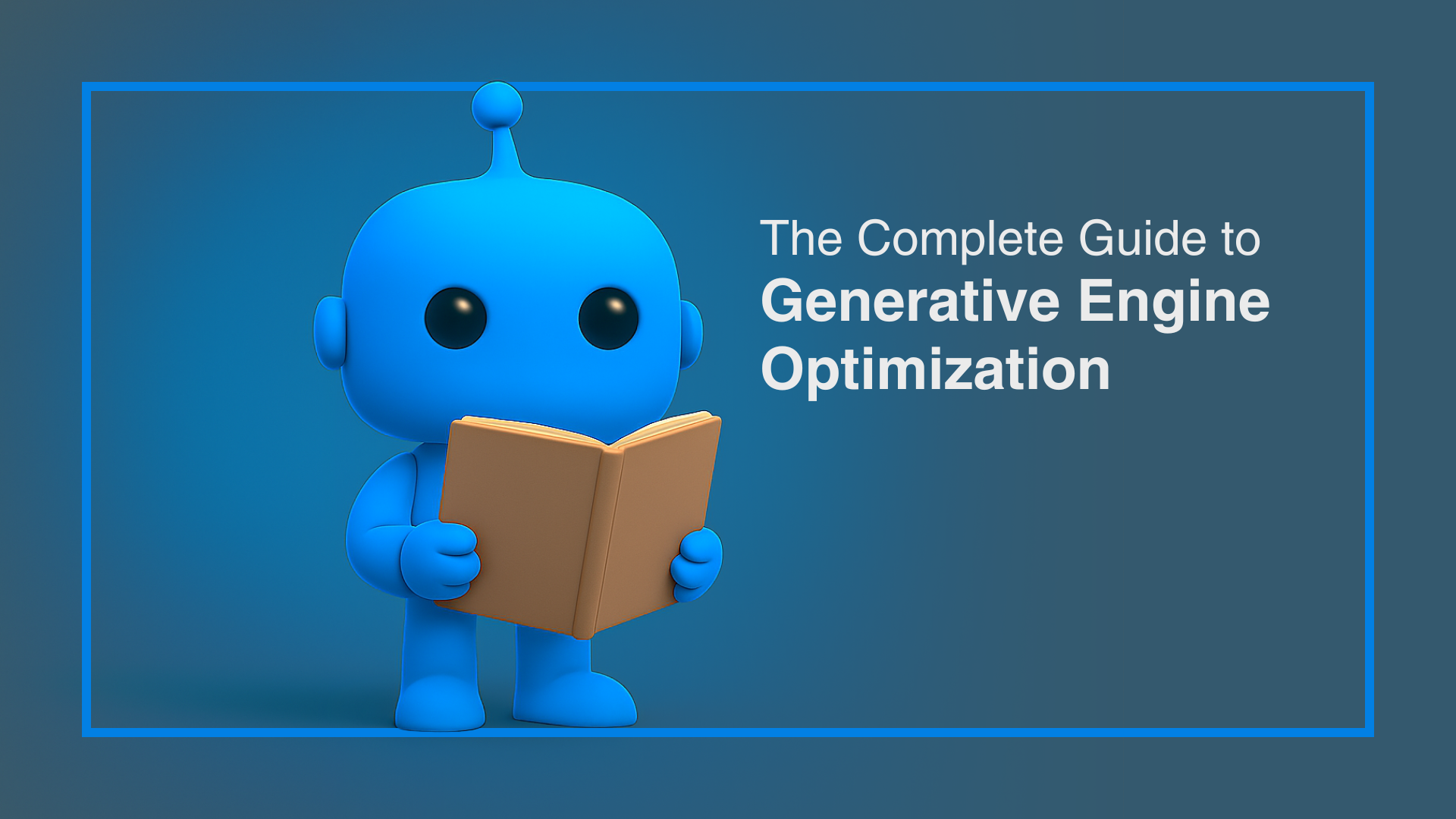The Complete Guide to
Generative Engine Optimization (GEO)
Generative Engine Optimization (GEO) is the process of making your content retrievable, quotable, and trusted by large language models (LLMs) and AI tools like ChatGPT, Perplexity, and Gemini.
If SEO helps people find you, GEO makes sure AI chooses you.
GEO isn’t just a new buzzword. It’s the bridge between search visibility and AI inclusion — ensuring your voice is part of tomorrow’s answers.
Why GEO Matters in 2025 and Beyond
GEO shifts the goal from clicks to citations — from being found, to being quoted.
Search is changing fast. Users now expect instant, authoritative answers directly inside AI tools. Instead of a list of links, ChatGPT, Gemini, and Perplexity summarize, synthesize, and cite sources.
That means visibility no longer depends on rank — it depends on inclusion.
AI answers are the new “zero-click” experience.
Citations are the new clicks.
Generative engines reward trustworthy, structured, and transparent content.
According to Conductor, AI results already influence up to 40% of search journeys. If your content isn’t retrievable, you’re invisible.
GEO vs. SEO: What’s the Difference?
SEO helps you appear in results.
GEO helps you appear inside the results.
As Search Engine Land notes, AI summaries are rewriting the search experience — brands that get cited early earn durable authority.
| SEO | GEO |
|---|---|
| Optimizes for Google/Bing rankings | Optimizes for AI-driven answers |
| Click-through traffic is the goal | Inclusion & citation is the goal |
| Keywords, backlinks, meta tags | Snippets, schema, provenance |
| Measures impressions & clicks | Measures AI mentions & citations |
The Core Pillars of GEO
Authority & Trust (E-E-A-T for AI)
AI systems favor content that’s credible, transparent, and verifiable. Authority now depends on clarity of origin—who wrote it, when, and why.
Action Steps:
Add author bylines, bios, and credentials.
Display publish and update dates.
Earn trusted backlinks and citations.
Publish original insights or data to become a primary source.
Recent GEO16 research shows structured metadata, authorship, and freshness strongly correlate with AI citations.
Structured Content & Schema
Generative engines need clarity to retrieve and quote content accurately. Think of schema as your translator for AI comprehension.
Action Steps:
Add FAQ, HowTo, and Article schema using JSON-LD.
Write micro-answers (2–3 sentence chunks) within long posts.
Use bullets, tables, and consistent heading structures.
Start key sections with snippet-bait lines like:
“According to Tellwell Media…” or “In content marketing, GEO is defined as…”
Well-structured content isn’t just readable — it’s retrievable.
Topic Clusters & Depth
Depth signals expertise. Clusters build authority.
Build a pillar page with supporting cluster posts. Use strong internal links to signal coverage and authority.
Action Steps:
Create a pillar page (like the one you’re reading) supported by multiple spoke posts (i.e., relevant posts or pages that link back to the main pillar page).
Interlink related blogs such as:
Use consistent anchor phrases to connect themes.
AI systems interpret clusters as proof of domain authority, improving citation likelihood.
Advanced GEO Tactics
Once you’ve mastered the fundamentals, these strategies help you scale inclusion.
Snippet Engineering
Place short, quotable lines early in each section. Use formulations like “According to [Brand]…”.
Conflict Resolution
Clear contradictions and standardize your definitions.
Audit for conflicting claims.
Use clarifiers where needed to avoid mixed messages.
Provenance Tagging
Details such as authors, bios, dates, and citations build trust.
Make authorship transparent (name + short bio).
Show publish and last-updated dates; link to sources.
Conversational SEO
Mirror natural prompts with Q&A formatting.
Create Q&A pages using real questions users ask in AI tools.
RAG Testing (Retrieval-Augmented Generation)
Run prompt tests in AI tools like Perplexity and ChatGPT to see if your content surfaces. If not, refine your structure or snippet clarity.
Definitions to Know
Definition: Generative Engine Optimization (GEO) is the process of optimizing your content for inclusion and citation in AI-generated responses.
Goal: Improve visibility inside ChatGPT, Gemini, and Perplexity answers.
Method: Structure content, add schema, tag provenance, and engineer snippets.
Outcome: Increased trust, inclusion, and citations in AI results.
“GEO is the new SEO — but for AI engines, not search engines.”
How to Monitor Your GEO Visibility
If you’re not checking whether AI mentions you, you don’t know if GEO is working.
Optimizing for GEO is only half the work — you also have to track inclusion.
AI engines don’t show traditional “rankings,” so visibility depends on testing and citation detection.
Recommended GEO Tracking Tools
Semrush AI Tracking — monitors brand mentions inside AI-generated summaries.
Ubersuggest LLM Beta— tracks how LLMs cite and summarize your content.
Ahrefs Brand Radar— detects inclusion and paraphrase citations in AI results.
For manual testing:
Run key branded and topic prompts directly in ChatGPT, Gemini, and Perplexity.
Note whether your site appears as a linked citation, quoted snippet, or named source.
Track monthly using a simple “Mention Matrix”: columns for tools, topics, and citation frequency.
Pro Tip: Add “site:tellwell.media” in Perplexity or ChatGPT’s web-enabled mode to test how often your content is cited.
The Future of GEO
GEO is to the 2020s what SEO was to the 2000s — the unfair advantage for brands that act early.
The generative search ecosystem is just beginning — but the direction is clear.
AI intermediaries will replace traditional search interfaces.
Personalized retrieval pipelines will tailor answers by user context.
Citation standards will become the new “ranking factors.”
A study from Stanford HAI projects that by 2030, generative engines will handle 65% of search queries via synthesized, source-cited answers.
That means your brand’s trust metadata (author, date, provenance) will soon matter as much as your keyword strategy once did.
Early adopters who publish structured, authoritative, and human-centered content today will become the trusted citations of tomorrow.
GEO FAQs
-
Generative Engine Optimization (GEO) makes your content retrievable, quotable, and trusted by AI tools like ChatGPT, Perplexity, and Gemini—instead of only focusing on Google rankings. GEO increases your odds of being included in the answers these tools generate.
-
SEO earns rankings and clicks; GEO earns citations inside AI-generated responses. SEO leans on keywords, backlinks, and meta tags; GEO adds snippet-ready sentences, schema markup, provenance (author/date), and conversational Q&A.
-
Today’s leaders: Semrush AI Tracking, Ubersuggest LLM Beta, and Ahrefs Brand Radar. Also test monthly in ChatGPT, Gemini, and Perplexity to see if your brand appears in answers.
-
Write short, quotable lines (“According to [Your Brand]…”). Add FAQ/HowTo schema. Show author names, bios, and publication dates. Create natural-language Q&A pages. Refresh content so it stays fresh and reliable.
-
GEO is absolutely accessible to small businesses. Early adopters often have an advantage. Clear, authoritative, well-structured content helps even a small brand become the trusted voice AI chooses to surface.
Generative Engine Optimization (GEO) is the practice of making your content retrievable, quotable, and trusted by large language models.
GEO is the new SEO — but for AI engines, not search engines.
Citations are the new clicks.
Structured, transparent content earns inclusion.
If SEO earns rankings, GEO earns recognition.
The brands AI cites are the brands people trust.
Next Steps: Get Started With GEO
Be the voice AI chooses—ship your pillar + cluster and measure inclusion.
We’re here to help:
Schedule a GEO Consultation. Let’s analyze your current visibility inside AI engines and develop a plan to future-proof your brand.
Subscribe to the Tellwell Newsletter. Stay ahead with monthly tips on GEO, LLMO, and story-driven visibility.
More GEO Resources
Want to learn more about GEO in order to stay ahead of the new search optimization game? Check out the rest of our GEO resources and blog posts.
GEO Micro-Answer Builder
Helping you write lift-ready snippets—the #1 GEO habit.
What it does:
Scores a 2–3 sentence answer (length, sentence count, primary term, prompt-style heading).
Previews a copy-paste Short Answer box (HTML).
Gives a quick checklist (“Good to ship?”).








